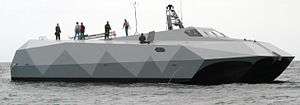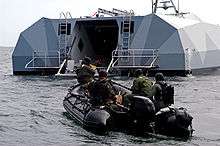M80 Stiletto
 | |
| History | |
|---|---|
| United States | |
| Name: | M80 Stiletto |
| Launched: | January 31, 2006 |
| Fate: | Trials,Development |
| General characteristics | |
| Class and type: | Experimental pentamaran |
| Displacement: | 60 tons full load |
| Length: | 88.6 ft (27.0 m) |
| Beam: | 40 ft (12 m) |
| Height: | 15 ft (5 m) |
| Draft: | 2.5 ft (0.8 m) |
| Propulsion: | 4 × 1,650 horsepower C-30 CAT |
| Speed: | 40 knots (74 km/h) cruise |
| Endurance: | 500 nm at full load/ max speed |
| Boats & landing craft carried: | 1 Rigid hull inflatable boat |
| Troops: | 12 SEALs |
| Complement: | 3 |
The M80 Stiletto is an American prototype naval ship of a new generation type of ship utilizing advanced stealth technologies,[3] it is manufactured and developed by American[4] naval architecture and maritime engineering company and defense contractor the M Ship Company[5] as an operational experimental ship testbed / class for The Pentagon’s Office of Force Transformation. It is notable for its advanced Pentamaran hull design and sophisticated carbon fiber and advanced material composite construction,[6] as well as its groundbreaking networked architecture.[7]
Design
The M80 Stiletto is a U.S. Navy vessel designed for combat in littoral waters. It takes the name from the Italian Stiletto, a long and narrow knife or dagger.
The 88-foot (27 m) long vessel has a notable hull design, an M-shaped hull that provides a stable yet fast platform for mounting electronic surveillance equipment or weapons, or for conducting special operations. The hull design does not require foils or lifting devices to achieve a smooth ride at high speeds in rough conditions. Its shallow draft means the M80 Stiletto can operate in littoral and riverine environments and potentially allows for beach landings. The faceted design suggests that the vessel has a low radar signature (i.e., stealth) in the frontal aspect and somewhat so from the sides.
The M80 Stiletto is equipped with four Caterpillar, Inc. C32 1232 kW (1652 HP) engines yielding a top speed in excess of 60 knots (110 km/h) and a range of 500 nautical miles (900 km) when fully loaded. It can be outfitted with jet drives for shallow water operations and beaching.
It has a topside flight deck for launching and retrieving unmanned aerial vehicles and a rear ramp that can launch and recover an 11-meter rigid-hull inflatable boats (RIB) or autonomous underwater vehicles (AUV).
It weighs 45 tons unloaded, light enough that it can be hoisted onto a cargo ship, while still able to carry up to 20 tons of cargo. The ship is 88.6 feet (27.0 m) in length, with a width of 40 feet (12 m) and a height of 18.5 feet (5.6 m), yet has a draft of only 2.5 feet (0.8 m).
The M80 Stiletto is the largest U.S. naval vessel built using carbon-fiber composites, advanced composite materials and epoxy building techniques, which yields a very light yet super strong hull. The prototype M80 Stiletto is expected to be in use in less than one year. Ships are expected to cost between $6 and $10 million.

Historically, ships have evolved to become narrower and deeper to achieve speed and stability. The M Hull however become wider, because its distinctively wide hull captures the vessel’s bow wave and redirects the energy under the hull. The Stiletto’s double-M hull enables the craft to achieve an unequaled ride in rough seas at high speed, which is critical for the Navy SEALS and other Special Operations Forces, because it reduces the G-forces and related injuries these personnel are subjected to during training and on missions.
The Stiletto is being tested by the United States Navy SEALs and Special Warfare Combat Crewmen, who operate small, fast craft in the rough littoral seas for which the vessel was designed.
Operational history
In 2006 and 2007, the Stiletto participated in Trident Warrior exercises, as well as a number of other naval exercises. This included three days of mine-clearing experimentation during Exercise Howler in 2006, when the vessel was operated by the Naval Special Clearance Team-1 (NSCT-1) from the Naval Amphibious Base in Coronado.
A key feature of this vessel is that it can set up a network between a special forces team by launching an unmanned aerial vehicle (UAV) that relays information between the team and boat. The Stiletto can also carry surveillance UAVs to provide reconnaissance for the SEAL team, and, using a clustered supercomputer on board, will be able to send real-time images to the team on shore.
The Stiletto was selected by Time magazine as one of the Best Inventions of 2006 and one of two inventions in the Armed Forces category.[8] San Diego-based CONNECT named the M80 Stiletto as the Most Innovative New Product for 2006 in the General Technology category.
In 2008, the Stiletto deployed on a 70-day mission for USSOUTHCOM as part of a joint agency operation that included the Drug Enforcement Administration and U.S. Coast Guard.[9]
In July 2012, the US Navy deployed a Stiletto to retrieve the NASA Inflatable Reentry Vehicle Experiment 3 (IRVE-3) test article[10] with 3 m (9.8 ft) diameter heat shield which splashed down in the Atlantic Ocean off North Carolina after being launched on July 23 by a sounding rocket from NASA's Wallops Flight Facility. The Stiletto is referenced as a maritime demonstration craft operated by the Naval Surface Warfare Center Carderock, Combatant Craft Division, and based at Joint Expeditionary Base Little Creek-Ft Story, Va.[11]
The UK is testing ISR packages compatible with the RQ-20A Puma hand-launched UAV on board the Stiletto in November 2014 under Capability Demonstration 15-1.[12]
See also
- HMS Smyge - Swedish trials ship
- Pentamaran
References
- ↑ http://www.naval-technology.com/projects/m80-stiletto/
- ↑ http://www.naval-technology.com/projects/m80-stiletto/
- ↑ http://www.defenseindustrydaily.com/stiletto-stealth-ships-look-different-ride-different-buy-different-01834/
- ↑ http://www.mshipco.com/about.html
- ↑ http://www.mshipco.com
- ↑ http://gizmodo.com/americas-largest-carbon-fiber-ship-is-a-seafaring-spee-1468513351
- ↑ http://www.naval-technology.com/projects/m80-stiletto/
- ↑ Low Rider - Time Magazine
- ↑ M Ship’s Stiletto Nabs Smugglers
- ↑ NASA Inflatable Reentry Vehicle IRV
- ↑ NASA Successfully Tests Hypersonic Inflatable Heat Shield
- ↑ Scott, Richard (26 October 2014). "Dstl plans unmanned ISR payload demonstration from Stiletto". IHS Jane's Defence Weekly.
External links
| Wikimedia Commons has media related to M80 Stiletto (ship, 2006). |
- Official Stiletto Principal Characteristics
- Official project website
- M80 Stilleto, from the M Ship Co.
- Article about testing of Stiletto
- Article about Stiletto transforming Navy
- Article about Stiletto operations against drug trafficking
- Project Information on the M80 Stiletto Naval Vessel
- Details and Specifications of the M80 Stiletto Naval Vessel